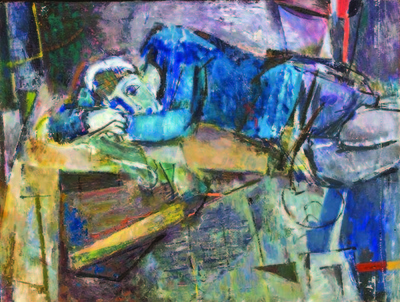Felix Lembersky: Soviet Form, Jewish Context
by Jenny Miller Sechler
On view now at the Yiddish Book Center, in Amherst, MA, is an exhibit Felix Lembersky: Soviet Form, Jewish Context, featuring paintings and drawings by the important but long-overlooked Soviet-era artist Felix Lembersky. The exhibit will be up through March 2015.
The Russian painter Felix Lembersky is an artist of survival. Born in 1913, his work documents war, genocide and repression, as well as an artistic vision that refused to follow the dictates of Soviet Russia. His work speaks to his direct experience: Lembersky was wounded in defensive operations outside Leningrad, presented his thesis during the Siege of Leningrad in 1941, and lost both parents to the Holocaust. The current exhibit of Lembersky’s work at the Yiddish Book Center in Hadley—Felix Lembersky: Soviet Form, Jewish Context—present the artist’s work along with accompanying materials that allow visitors to fully experience the artist’s bravery along with the beauty of his paintings.
Born in Poland and raised in the Ukraine, Lembersky studied at the Jewish Arts and Trade School and the Kiev Arts Academy, before leaving the city at age 22 to study in Leningrad. Although Lembersky’s decision to leave the Ukraine didn’t protect him from the horror of World War II, it allowed him to survive the Nazi atrocities that eventually took his parents, a subject he revisits in his work.
Lembersky was a prolific painter, as well as a teacher throughout his life, enjoying support and respect of fellow Soviet artists. This support afforded him some protection from being targeted for persecution by the Communist Party. Lembersky didn’t directly challenge Soviet art policy; rather, he ignored it, choosing to follow the lead of his own imagination. For this, he was marginalized as an artist, despite his early recognition and promise. On the artist’s webpage, his daughter notes, “Under the Stalinist regime, my father was offered fame, wealth, position and endless opportunities to paint.” Instead, “he chose poverty, persecution, and deprivation.”
Felix Lembersky: Soviet Form, Jewish Context presents works from throughout Lembersky’s career. The exhibit begins with a room of portraits that display the way Lembersky’s style developed over time, as well as the influences of fauvism, cubism and expressionism. While Lembersky’s portraits reflect Soviet edicts to represent common people, his paintings find his subjects in quiet, contemplative moods, often turning inward, rather than presenting an image of a proud, engaged proletariat. Old Man in Red Shirt, Old Miner (1958) provides an example of the intimacy of his portraits, as well as his generous celebration of color.
The second room in the exhibit features Lembersky’s factory and city scenes, as well as three arresting images of war. Entering the room, visitors are met by the painting Untitled Execution, from Lembersky’s Babi-Yar series painted between 1942 and 1944. Lembersky is the first known artist to address the Nazi atrocities at Babi-Yar, outside of Kiev. Painted in muted tones, Untitled Execution, is full of movement and depth. Although the painting is representational, the figures are conveyed with blurred brush strokes and are hard to discern. The lack of clarity increases the painting’s haunting nature: something frightening is happening, but it is difficult to tell what.
Untitled Execution presents a striking contrast to two later paintings from his Siege of Leningrad series, which end the exhibit. While these paintings include bright colors and abstracted forms, the figures represented are in the foreground and dominate the paintings. In the case of Lezhaschaya, painted in 1964, the woman pictured looks directly at the viewer. The emotion on her face, conveyed in simple visual language, is unmistakable. She is devastated, but she is alive.
The supporting materials provided by the Yiddish Book Center are fascinating. They include information about the formation of the Jewish Autonomous Region, created by the Communists to discourage Zionism, as well as Soviet Orthographic reform and its impact on Yiddish. The Soviet Union was masterful in the way it usurped its citizens’ unique culture and practices to encourage loyalty to the Communist Party. Artists were fully employed in these endeavors, and often met execution if they failed to comply. A case presenting documents from “The Night of the Murdered Poets,” tells the story of how the Communist Party turned against a group of poets when they no longer served the Party’s purposes.
In the face of the Soviet persecution of artists, Lembersky’s commitment to develop his unique voice is remarkable. “We are the spokesmen and the engineers of the human souls,” the artist said, in a speech in Leningrad in 1960. “Allow us to speak in full voice about what we feel and understand and how it should be.” Lembersky’s voice, as represented in his work, doesn’t shrink from suffering, but is full of humanity and beauty.
Felix Lembersky: Soviet Form, Jewish Context will be on display at the Yiddish Book Center, 1021 West Street, Amherst, MA through March 2015
________________________________________________________________________________________________
Image Credit: Images courtesy of the Yiddish Book Center.
________________________________________________________________________________________________
Jenny Miller Sechler is an arts writer living in Northampton, Massachusetts, where she serves on the board of Northampton Arts, Inc.


